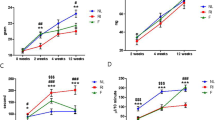Background and Purpose:
Salivary gland impairment following high-dose radioiodine treatment is well recognized. Since differentiated thyroid cancer has a good prognosis, reduction of long-term side effects is important. This study investigates the radioprotective effects of amifostine in salivary glands of rabbits receiving high-dose radioiodine therapy so as to obtain deeper insight in changes on the cellular and ultrastructural level.
Material and Methods:
A total of 20 rabbits were investigated. High-dose radioiodine therapy applying 1 GBq 131I was performed in 16 animals. Eight of these 16 animals received 200 mg/m2 body surface amifostine prior to high-dose radioiodine therapy. Four additional rabbits served as controls, two receiving amifostine, the other two no treatment at all. Subsequently, salivary glands (submandibular and parotid glands, respectively) of all animals were examined by light and transmission electron microscopy.
Results:
Parenchymal damage of both parotid and submandibular glands, specially acinar structures comprising cell organelles and nuclei, of animals pretreated with amifostine was much less pronounced than in animals without amifostine pretreatment.
Conclusion:
The results indicate that parenchymal damage in salivary glands induced by high-dose radioiodine therapy can significantly be reduced by amifostine. Therefore, amifostine therapy may increase quality of life in patients with differentiated thyroid cancer after radioiodine treatment.
Hintergrund und Ziel:
Die Schädigung von Speicheldrüsengewebe durch Radiojodtherapie ist bereits beschrieben. Da differenzierte Schilddrüsenkarzinome eine gute Prognose besitzen, ist die Reduktion von Langzeitnebenwirkungen bei der Radiojodtherapie von großer Bedeutung. In dieser Studie werden die radioprotektiven Auswirkungen nach Gabe von Amifostin auf Speicheldrüsen von Kaninchen nach Hochdosis-Radiojodtherapie untersucht, um genauere Kenntnis über Veränderungen auf dem zellulären und ultrastrukturellen Sektor zu erlangen.
Material und Methodik:
20 Kaninchen wurden untersucht. Eine Hochdosis-Radiojodtherapie mit 1 GBq 131I wurde bei 16 Kaninchen angewendet. Acht dieser 16 Tiere erhielten 200 mg/m2 Körperoberfläche Amifostin vor Hochdosis-Radiojodtherapie. Vier weitere Kaninchen dienten als Kontrolle, zwei erhielten Amifostin, die beiden anderen keine Therapie. Anschließend wurden die Speicheldrüsen (Glandula submandibularis und Glandula parotidea) aller Tiere mit Hilfe von Licht- und Elektronenmikroskopie untersucht.
Ergebnisse:
Die Schädigung des Parenchyms, insbesondere von Zellorganellen und Zellkernen der Azini, der Glandulae parotidea und submandibularis von Kaninchen, die mit Amifostin vorbehandelt waren, war bedeutend geringer ausgeprägt als bei den Tieren ohne Amifostingabe.
Schlussfolgerung:
Die Ergebnisse verdeutlichen, dass der durch eine Hochdosis-Radiojodtherapie hervorgerufene Schaden in den Speicheldrüsen durch die Gabe von Amifostin signifikant reduziert werden kann. Die Lebensqualität von Patienten mit differenziertem Schilddrüsenkarzinom könnte somit durch die Anwendung von Amifostin verbessert werden.
Similar content being viewed by others
Author information
Authors and Affiliations
Corresponding author
Additional information
* The animal experiments were done at the Clinic of Nuclear Medicine, Kiel University Hospital, and the light and electron microscopic investigations were done at the Department of Anatomy, Christian Albrecht University of Kiel.
Rights and permissions
About this article
Cite this article
Kutta, H., Kampen, U., Sagowski, C. et al. Amifostine is a Potent Radioprotector of Salivary Glands in Radioiodine Therapy. Strahlenther Onkol 181, 237–245 (2005). https://doi.org/10.1007/s00066-005-1353-3
Received:
Accepted:
Issue Date:
DOI: https://doi.org/10.1007/s00066-005-1353-3




